NSMT Loudspeakers 20M Armada System by Terry London
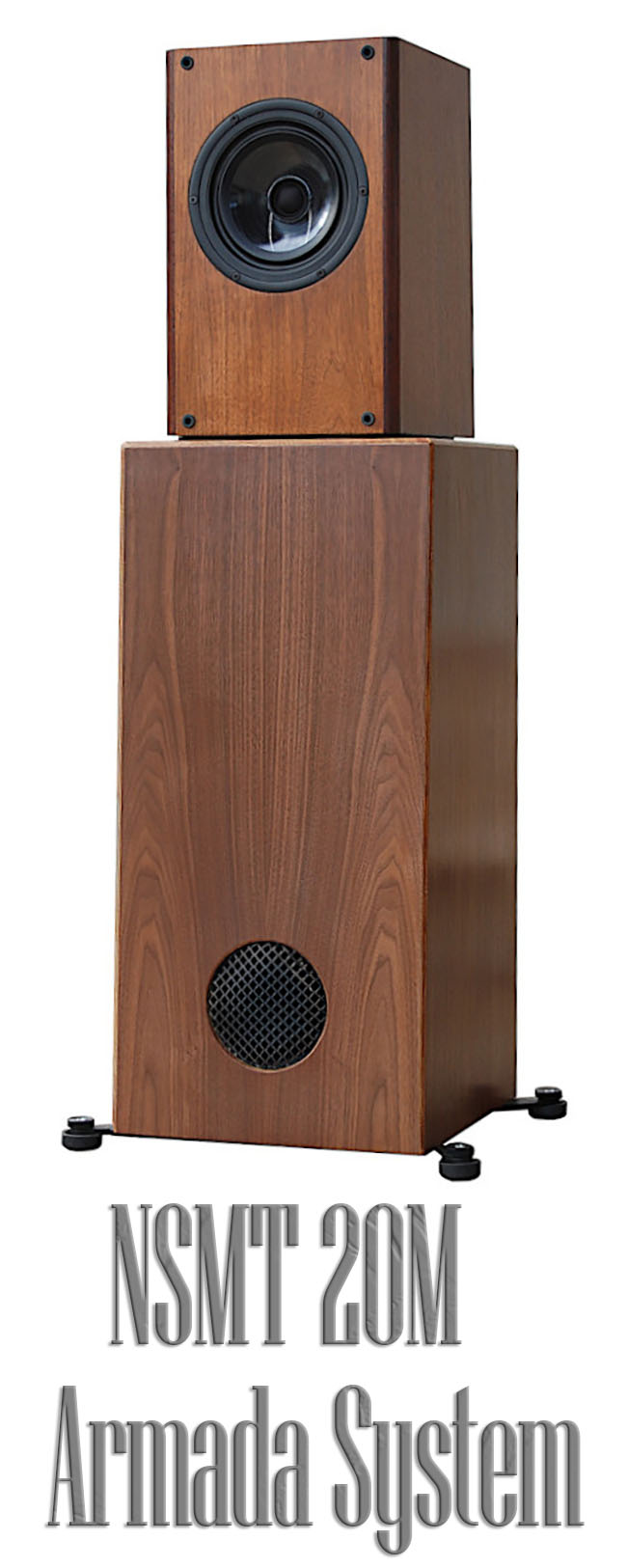
 NSMT Loudspeakers is one of the great US boutique companies that hand builds and designs some of the finest musical transducers, including stand-mount monitors, sub-woofers, and floor-standers on the market today. Located in Research Triangle, North Carolina, NSMT Loudspeakers was started over twenty years ago by Erol Ricketts, who designs all models and then hand-builds them out of the finest materials available. Based on my numerous past reviews of NSMT speakers, it is apparent that Mr. Ricketts is a master at selecting different acoustic strategies (sealed box, transmission line, active bandpass/subwoofer) and then explores which drivers regarding tonality/timbres work the best in his other speaker models. In my experience, the great manufacturers of stereo gear have a “house sound” that prevails from their least expensive models up to their reference pieces. As you go up in their product line, you get more precision/finesse and a filling out of their “take” of a live musical performance. Examples would be Coda Technologies, Pass Labs, Audio Note UK, Tekton Design, and Harbeth Speakers. Suppose you have the same “taste” as the head designer and his team regarding how you experience music in an aesthetically rewarding fashion. In that case, you tend to want to work yourself up that companies’ line of models because each one is a step closer to fulfilling your musical quest of enjoyment.
NSMT Loudspeakers is one of the great US boutique companies that hand builds and designs some of the finest musical transducers, including stand-mount monitors, sub-woofers, and floor-standers on the market today. Located in Research Triangle, North Carolina, NSMT Loudspeakers was started over twenty years ago by Erol Ricketts, who designs all models and then hand-builds them out of the finest materials available. Based on my numerous past reviews of NSMT speakers, it is apparent that Mr. Ricketts is a master at selecting different acoustic strategies (sealed box, transmission line, active bandpass/subwoofer) and then explores which drivers regarding tonality/timbres work the best in his other speaker models. In my experience, the great manufacturers of stereo gear have a “house sound” that prevails from their least expensive models up to their reference pieces. As you go up in their product line, you get more precision/finesse and a filling out of their “take” of a live musical performance. Examples would be Coda Technologies, Pass Labs, Audio Note UK, Tekton Design, and Harbeth Speakers. Suppose you have the same “taste” as the head designer and his team regarding how you experience music in an aesthetically rewarding fashion. In that case, you tend to want to work yourself up that companies’ line of models because each one is a step closer to fulfilling your musical quest of enjoyment.
Every review I have done on NSMT Loudspeaker’s models, from the least expensive to the top line references, has provided me with music pleasure in three key areas:
All of the NSMT speakers offer beautiful/natural tonality, timbres, and colors of musical instruments.
All are “champs” at sound staging and imaging.
Mr. Rickett’s is a world-class master at transmission line loading/bandpass subwoofers, leading to deep, accurate bass with subsonic extension that can load and surprisingly pressurize a room, based on the size of the cabinet.
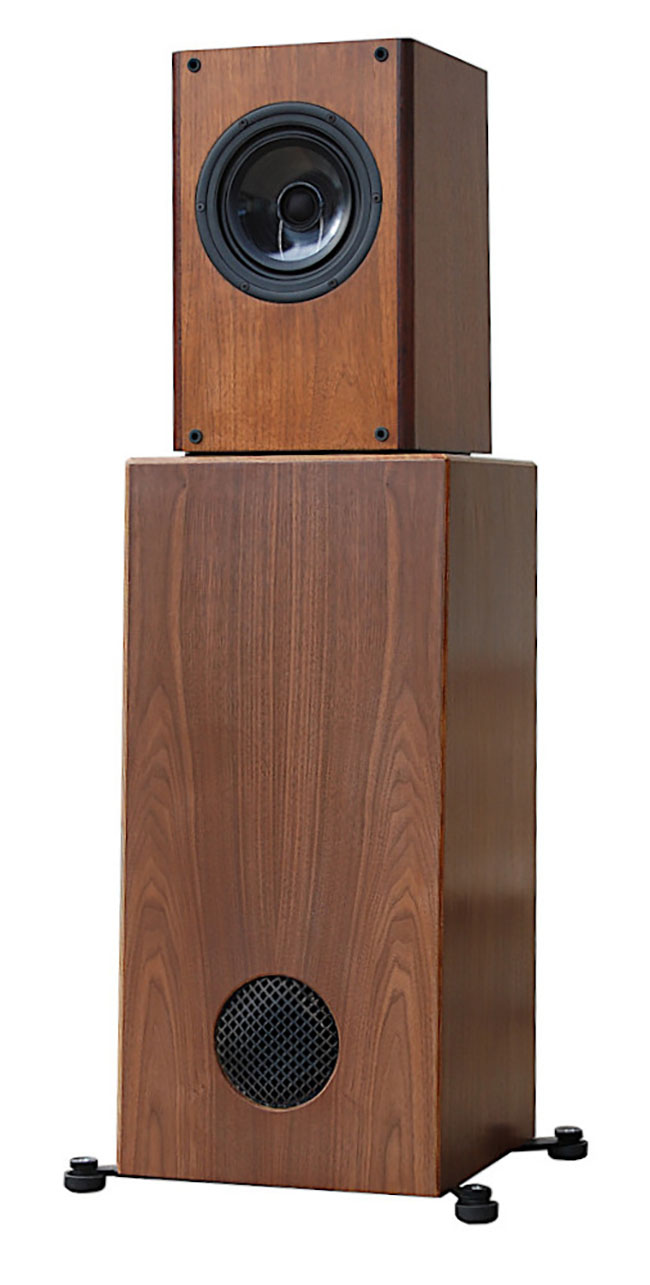
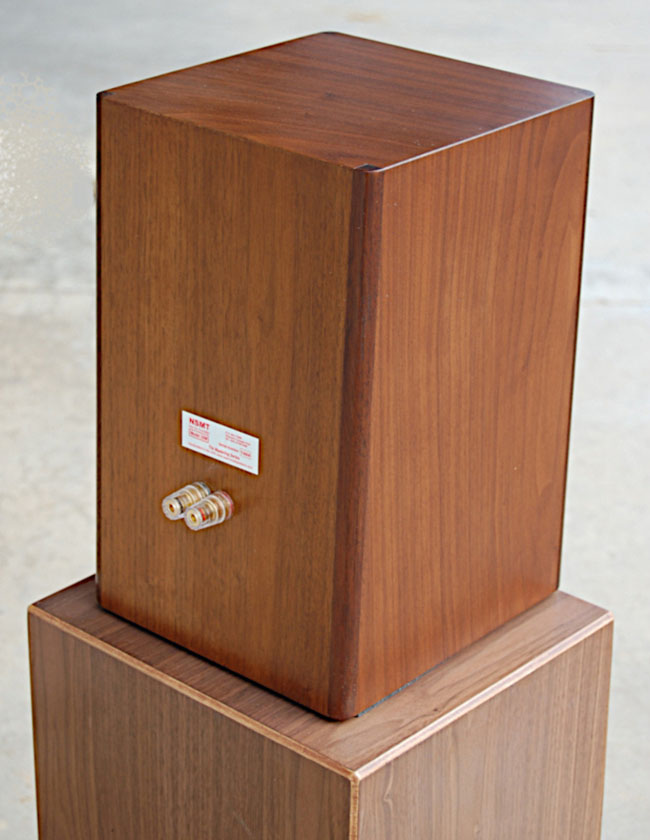
This review is on the brand new two-piece 20M Armada, a two-way, first-order, time coherent, point source, monitor, and an active pedestal bandpass subwoofer system (Russell Lichter wrote on the original model here). The monitor dimensions are 14″ high by 9″ wide by 9.5″ deep. Each monitor weights 28 pounds. It is a single driver design that uses a 7 inch cast magnesium frame TPX mid/woofer driver and a 1 inch soft dome silk tweeter arranged as a coincident point source. This design produces a stable, symmetrical, radiation pattern with none of the drop-off in sound dispersion that is characteristic of conventional driver arrangements. The monitor’s crossover is a first order minimalist design consisting of a perfect lay air core copper inductor and a film foil capacitor. The 20M Armada pedestal active bandpass subwoofer uses a 10 inch paper cone subwoofer driver. It is ported on the front, driven by a 250 watt amplifier with adjustable crossover, phase, and volume control. This approach allows the excellent transient response of acoustic suspension designs and the dynamic ease of vented designs. Its dimensions are 25″ high by 12″ wide by 12″ deep. Each pedestal weighs 37 pounds. Both the monitor and pedestal connectors are high-quality five-way gold plated binding posts. The 20M Armada’s frequency response is rated 27Hz to 20kHz +/- 2.5 dBs. The rated impedance is 8 Ohms. Each piece of the 20M Armada retails for $5000; therefore total cost is $10000. The pair shipped to me for review wherein a beautiful walnut hand-rubbed grain. As you will see further into the review, I drove the 20M Armada system with multiple amplifiers with superlative results. They were spaced four feet off the front wall, three and a half feet off the sidewalls, and spaced six feet apart from each other.
 My go-to album to evaluate both a speaker’s ability with overall macro-dynamics/transient speed and bass extension/control is jazz organist Ben Paterson’s CD “For Once in My Life.” This a terrific high-quality recording of the explosive drum work of the drummer of this B-3 Hammond organ trio, George Fludas, along with Mr. Paterson’s deep bass pedal runs. The 20M Armada effortlessly, even at very high volume levels, allowed the percussive bass drum kicks to fill my acoustic space. The deep extension of the B-3 Hammond organ’s bass pedals notes was extremely hard-hitting, but tonality was accurate. I was feeling the psychical ambient air pressure waves as much as hearing the bass notes.
My go-to album to evaluate both a speaker’s ability with overall macro-dynamics/transient speed and bass extension/control is jazz organist Ben Paterson’s CD “For Once in My Life.” This a terrific high-quality recording of the explosive drum work of the drummer of this B-3 Hammond organ trio, George Fludas, along with Mr. Paterson’s deep bass pedal runs. The 20M Armada effortlessly, even at very high volume levels, allowed the percussive bass drum kicks to fill my acoustic space. The deep extension of the B-3 Hammond organ’s bass pedals notes was extremely hard-hitting, but tonality was accurate. I was feeling the psychical ambient air pressure waves as much as hearing the bass notes.
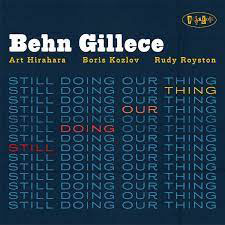 On my following selection, vibraphonist Behn Gillece’s album “Still Doing Our Thing,” I became aware of one of the great strengths of the 20M Armada’s sonic virtues, its complete and total transparency. It had the purity of tonality and ease of hearing the smallest micro-details in the mid-range commonly associated with single-driver designs. I could tell when Gillece changed from hard to soft mallets during the same track because different decays and tones were created off the vibraphone’s bars when he switched his mallets. None of this was analytical or sounded like the music was under a microscope but was woven into a seamless tapestry of sound. One of my veteran audiophile friends tried to describe how the 20M Armada sounded to him. He came up with, “it has the speed and details of a big electrostatic panel, with more accurate sized images, but with “big balls” bass and dynamics.”
On my following selection, vibraphonist Behn Gillece’s album “Still Doing Our Thing,” I became aware of one of the great strengths of the 20M Armada’s sonic virtues, its complete and total transparency. It had the purity of tonality and ease of hearing the smallest micro-details in the mid-range commonly associated with single-driver designs. I could tell when Gillece changed from hard to soft mallets during the same track because different decays and tones were created off the vibraphone’s bars when he switched his mallets. None of this was analytical or sounded like the music was under a microscope but was woven into a seamless tapestry of sound. One of my veteran audiophile friends tried to describe how the 20M Armada sounded to him. He came up with, “it has the speed and details of a big electrostatic panel, with more accurate sized images, but with “big balls” bass and dynamics.”
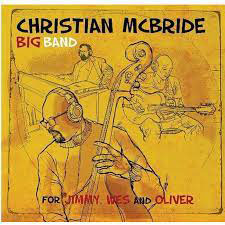 My final selection is one of my favorite jazz recordings of the last two years, bassist Christen McBride’s big band recording “For Jimmy, Wes, and Oliver.” The ability and skill of the musicians playing great big band arrangements are top-notch, and the recording quality regarding panoramic sound-staging and layering of the players of this big band is exceptionally natural and lifelike. Like all great small monitors, the 20M Armada rendered a wall to wall precisely layered sound-stage along with a deep center fill with each player’s position located on this stage.
My final selection is one of my favorite jazz recordings of the last two years, bassist Christen McBride’s big band recording “For Jimmy, Wes, and Oliver.” The ability and skill of the musicians playing great big band arrangements are top-notch, and the recording quality regarding panoramic sound-staging and layering of the players of this big band is exceptionally natural and lifelike. Like all great small monitors, the 20M Armada rendered a wall to wall precisely layered sound-stage along with a deep center fill with each player’s position located on this stage.
All of the above listening experiences were delivered by setting up the 20M Armada in stock form. I made two changes that took the performance of the 20M Armada to a slightly higher but noticeable level, regarding even more of a see-through resolution and a tightening of the potent lower bass frequencies. First, instead of the stock feet on the pedestal and just seating the monitor on the top surface of the pedestal, I inserted IsoAcoustics OREA footers underneath the pedestal and between the top of the pedestal and the bottom of the monitor. Secondly, I reached out to Chris Sommovigo of Graceline Cables to build me a pair of custom jumper cables to replace the stock cables between the monitor and the active bandpass subwoofer pedestal. I have recommended to Mr. Ricketts to consider each of these upgrades as a possible offering to his 20M Armada stock model.
After completing my reviewing process of the NSMT Loudspeaker 20M Armada system, it was time to explore the possibilities of using the 20M Armada’s active bandpass subwoofer pedestal as a platform for other types of monitor speakers. Many readers will be familiar with the term “tube rolling.” I started the “monitor rolling” process and had a fascinating experience and a lot of fun doing this activity. I acquired over seven monitor speakers to evaluate how universal the active bandpass subwoofer application and its effect would be with other manufacturers’ speaker models. The list was composed of speakers from $600 to $6000 in price from Canton, Wharfedale, Sonus Faber, Harbeth, Role, and Mhi. Some models used AMT, silk domes, ceramic, metal, and ribbon drivers. Each had its own sonic signature, based on its driver’s materials and their overall design principles.
Here’s what I discovered:
1) The NSMT active bandpass subwoofer was very easy to tune in for optimum performance with each monitor because of its excellent adjustments regarding crossover settings, phase adjustment, and volume levels.
2) If you were blindfolded and did not know you were listening to a small two monitor design with the 20M Amada pedestal, of course, you would swear you were listening to a full-range floor-standing speaker or large panel design with unlimited dynamics and sub-sonic bass extension.
3) With the 20M Amada active bandpass subwoofer pedestal, each monitor’s voicing was not lost or interfered with. Still, the power foundation of the lower mid-range and upper bass frequencies was blended seamlessly with that monitor speaker. So, suppose you love Harbeth Speaker’s house sound and want to get very close to their $24,000 full-range reference, get one of their smaller monitors, and mount it on the NSMT pedestal for a lot less money! By the way. In that case, I have in-house two pairs of excellent subwoofers. When I used them perfectly dialed-in with these different monitors, it extended the bass extension but never filled in the power foundation and did not transform the small monitors into the illusion of a full range floor-standing model. I know what my ears tell me. However, I wanted Mr. Ricketts to explain how and why his design sounds qualitatively different than a standard subwoofer design.
 “The hallmark of the NSMT Bass Foundation Subwoofer is its ability to integrate well with large and small speakers. The NSMT design integrates seamlessly because its bandpass design produces a faster transient response and flatter bass response over a wider frequency range than most subwoofers. The woofer’s back is mounted in an acoustic suspension sub closure in a bandpass design that produces a quick, accurate, transient response and flat, extended bass. Bandpass subwoofers are challenging to design because the designer has to consider the design of the acoustic suspension rear enclosure, the design of the front enclosure, and the size and tuning of the port. As the bandpass suggests, the cabinet acts as a lowpass filter that shapes the bandwidth of frequencies that it outputs. The designer manipulates that bandwidth by shifting values for the rear enclosure, the front enclosure, and the port. A well-designed bandpass subwoofer has a better transient response and better bass extension than alternative designs of similar size. Moreover, as in a transmission line design, in the bandpass design, the woofer can generate high dynamic levels without distortion because cone motion is controlled and reduced by air pressure on both sides of the woofer cone. And, like acoustic suspension design, bandpass design produces a natural extended 12 dB low-end frequency roll-off with an excellent transient response. While the frequency response of most active subwoofers tends to be dependent on elaborate artificial shaping of the response by electronic means, the Bass Foundation Subwoofer achieves exemplary, transient response and extended linear frequency primarily through the natural and harmonious acoustic mating of its woofer and its bandpass cabinet.
“The hallmark of the NSMT Bass Foundation Subwoofer is its ability to integrate well with large and small speakers. The NSMT design integrates seamlessly because its bandpass design produces a faster transient response and flatter bass response over a wider frequency range than most subwoofers. The woofer’s back is mounted in an acoustic suspension sub closure in a bandpass design that produces a quick, accurate, transient response and flat, extended bass. Bandpass subwoofers are challenging to design because the designer has to consider the design of the acoustic suspension rear enclosure, the design of the front enclosure, and the size and tuning of the port. As the bandpass suggests, the cabinet acts as a lowpass filter that shapes the bandwidth of frequencies that it outputs. The designer manipulates that bandwidth by shifting values for the rear enclosure, the front enclosure, and the port. A well-designed bandpass subwoofer has a better transient response and better bass extension than alternative designs of similar size. Moreover, as in a transmission line design, in the bandpass design, the woofer can generate high dynamic levels without distortion because cone motion is controlled and reduced by air pressure on both sides of the woofer cone. And, like acoustic suspension design, bandpass design produces a natural extended 12 dB low-end frequency roll-off with an excellent transient response. While the frequency response of most active subwoofers tends to be dependent on elaborate artificial shaping of the response by electronic means, the Bass Foundation Subwoofer achieves exemplary, transient response and extended linear frequency primarily through the natural and harmonious acoustic mating of its woofer and its bandpass cabinet.
The Bass Foundation Subwoofer is designed to provide considerable frequency overlap with the main speakers running full range. I choose a bandpass design because my design principle is to make the loudspeaker system act as one full-range driver. That entails considerable frequency overlap in the drivers’ output and continuity in the transient response of the speaker system. My preference is to use the subwoofer to “reinforce” the full-range bass performance of the main speakers. It is inspired by my understanding of psycho-acoustics and bass reproduction. Most of the desire to drive loudspeakers very loud is driven by a desire to pressurize the air in the room. Secondly, using crossovers to partition bass frequencies between the subwoofer and main speaker drivers creates phase irregularities and transient response discontinuity in bass reproduction. My bass reinforcement approach requires a subwoofer with variable, flat bass response over a wide range of bass frequencies and the best approach is to use a bandpass design. The Bass Foundation Subwoofer has a variable quasi-anechoic frequency response of +/- 3 dB from 24 Hz to 145 Hz.”
 The NSMT Loudspeaker 20M Armada speaker is a two-piece design that offers reference level sonic attributes in the following areas. It does spatial qualities like a great two-way stand-mount monitor regarding imaging and staging that are truly wall to wall. The speaker completely disappears into the environment where the music was recorded. It resolves very fine details without sounding etched or analytical. The 20M Amada monitor is dead neutral to give pristine/pure timbres and tonality. However, be careful with your upstream equipment; if the tonality or color is bleached out in your source or amplification, you will hear it through this speaker. On the other hand, if your gear has organic warmth and truth in timbres, you are in for a delightful music experience. The 20M Amanda looks beautiful because of the walnut wood finish and the superlative woodworking skills of MSNT. Lastly, the 20M Armada produces the power range of the music (lower mid-range and the upper bass region) with great clarity, yet can produce the power and subsonic of the lowest bass frequencies with authority to pressurize your acoustic space in a lifelike way that is amazing considering its small footprint. Finally, suppose you own a pair of monitors that give you great musical pleasure overall but are certainly limited because of their physical size in their ability to produce bass frequencies to fill out the foundation of music and pressurize your acoustic space. In that case, the 2M Amada active bandpass subwoofer pedestal is something you honestly might want to investigate in the future.
The NSMT Loudspeaker 20M Armada speaker is a two-piece design that offers reference level sonic attributes in the following areas. It does spatial qualities like a great two-way stand-mount monitor regarding imaging and staging that are truly wall to wall. The speaker completely disappears into the environment where the music was recorded. It resolves very fine details without sounding etched or analytical. The 20M Amada monitor is dead neutral to give pristine/pure timbres and tonality. However, be careful with your upstream equipment; if the tonality or color is bleached out in your source or amplification, you will hear it through this speaker. On the other hand, if your gear has organic warmth and truth in timbres, you are in for a delightful music experience. The 20M Amanda looks beautiful because of the walnut wood finish and the superlative woodworking skills of MSNT. Lastly, the 20M Armada produces the power range of the music (lower mid-range and the upper bass region) with great clarity, yet can produce the power and subsonic of the lowest bass frequencies with authority to pressurize your acoustic space in a lifelike way that is amazing considering its small footprint. Finally, suppose you own a pair of monitors that give you great musical pleasure overall but are certainly limited because of their physical size in their ability to produce bass frequencies to fill out the foundation of music and pressurize your acoustic space. In that case, the 2M Amada active bandpass subwoofer pedestal is something you honestly might want to investigate in the future.


Terry London
Specifications:
NSMT 20M Monitor
Price: $10k pair
Sensitivity: 87 dB 1 watt/m
Rated Impedance: 8 ohms
Minimum Impedance: 6.5 Ohms
Recommended Power: 5 – 200 watts
Shipping Weight monitor: 50 pounds per pair
Bass Foundation Active Bandpass Subwoofer
250 Watt amplifier
10-inch long-throw treated paper cone woofer
Auto-on power switch controlled by input signal
Continuously variable crossover from 40 Hz to 180 Hz at 24 dB/octave
Volume control to adjust output
Overload and thermal and fuse protection with output relay
Gold plated RCA line-level input and output connectors
Removable IEC type power cord
Discrete TO-3P output devices
THD: Less than 0.05%
S/N ratio: Greater than 85dB
Power requirements: Switchable, 120/240 VAC, 50/60 Hz
Shipping weight: 45 pounds each
Warranty: 5-year limited warranty.
Website: https://nsmt-loudspeakers.com/
The front of the cabinet is slanted 2 degrees, from the bottom to the top to improve phase alignment between the subwoofer and the partnering monitor and to eliminate standing waves in the cabinet.
TJ’s Associated Equipment
Sources:
Audio Note UK 3.1 Balanced
Mhdt Lab Balanced Pagoda
Pass Labs DAC-1
Jay’s Audio MK-II transport
CEC-3 belt-driven transport
Amplification:
Coda 07x preamplifier
AricAudio Motherlode MKII preamplifier
SPL Elector preamplifier
Coda # 16.0 amplifier
SPL S/800 amplifier
Threshold 550e amplifier
Pass Labs XA-25 amplifier
Loudspeakers:
NSMT Loudspeaker Model 100
Tekton Design Ulfberth & Perfect Set
NSMT Loudspeaker 20A Amanda
Accessories:
Full loom Black Cat 3232 XLR’s & Digit 110 AES/EBU
Kirmuss Adrenaline speaker wire
Krolo Design reference rack & footers
Puritan Design Labs conditioner & grounding box
Audio Archon power cords
Stereo Times Masthead
Publisher/Founder
Clement Perry
Editor
Dave Thomas
Senior Editors
Frank Alles, Mike Girardi, Key Kim, Russell Lichter, Terry London, Moreno Mitchell, Paul Szabady, Bill Wells, Mike Wright, Stephen Yan, and Rob Dockery
Current Contributors
David Abramson, Tim Barrall, Dave Allison, Ron Cook, Lewis Dardick, Dan Secula, Don Shaulis, Greg Simmons, Eric Teh, Greg Voth, Richard Willie, Ed Van Winkle, and Rob Dockery
Music Reviewers:
Carlos Sanchez, John Jonczyk, John Sprung and Russell Lichter
Site Management Clement Perry
Ad Designer: Martin Perry







Be the first to comment on: NSMT Loudspeakers 20M Armada System by Terry London